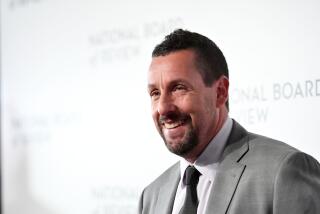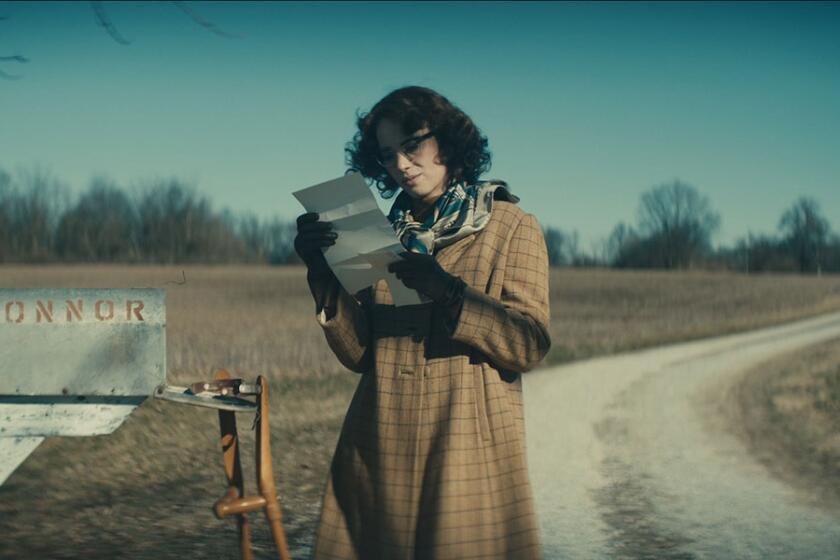‘Avatar’s’ animated acting
Director James Cameron had many reasons to be happy the morning that this year’s Oscar nominations were announced; his blockbuster film “Avatar” tied for the most with nine, including best picture and best director. But he was dismayed that his cast, including stars Zoe Saldana, Sam Worthington and Sigourney Weaver, was shut out.
In fact, unlike the great majority of best picture nominees, the “Avatar” actors have not nabbed a single major critic’s award, or guild prize. The snubs reflect the apparent ambivalence of the film community -- especially actors -- to “Avatar” and its revolutionary use of “performance capture,” a new technology that combines human actors with computer-generated animation to create the blue, 10-foot-tall creatures who are the heart of the movie.
To the uninitiated, it raises basic questions: Is this acting, or is it animation? And, does this suggest that actors could become obsolete? It’s an issue that provokes a strong response from Hollywood figures, from best actor nominees Jeff Bridges and Jeremy Renner, to directors Cameron and Steven Spielberg.
“I’m sure they could do it now if they wanted. Actors will kind of be a thing of the past,” Bridges told The Times the day nominations were announced. “We’ll be turned into combinations. A director will be able to say, ‘I want 60% Clooney; give me 10% Bridges; and throw some Charles Bronson in there.’ They’ll come up with a new guy who will look like nobody who has ever lived and that person or thing will be huge,” he said.
Renner, nominated for “The Hurt Locker,” put it this way: “Some movies are actors’ kind of movies and some movies are more directors’ movies. ‘Avatar’ is a spectacle. It’s a beautiful experience, but it’s not really an actors’ kind of movie. It doesn’t really allow for an actor to truly tell a story. The director’s telling the story in that one.”
Perhaps mindful that actors make up the largest Oscar voting bloc, Cameron fiercely promotes the contributions of his cast to the success of “Avatar.” He and other advocates of performance capture (known as “motion capture” in its previous, less sophisticated incarnation), including Spielberg, say not enough actors have experienced the process to appreciate it.
“There’s a learning curve for the acting community, and they’re not up to speed yet,” Cameron said. “We didn’t get out and proselytize with the Screen Actors Guild as we probably should have to raise awareness. Not only should they not be afraid of it, they should be excited about it. There is a new set of possibilities, after a century of doing movie acting in the same way.”
Cameron describes it as “an actor-driven process.”
“I’m not interested in being an animator. . . . That’s what Pixar does. What I do is talk to actors. ‘Here’s a scene. Let’s see what you can come up with,’ and when I walk away at the end of the day, it’s done in my mind. In the actor’s mind, it’s done. There may be a whole team of animators to make sure what we’ve done is preserved, but that’s their problem. Their job is to use the actor’s performance as an absolute template without variance for what comes out the other end. “
“I like to think of it as digital makeup, not augmented animation,” said Spielberg, who is using Cameron’s “Avatar” technology in his new movie, “The Adventures of Tintin: The Secret of the Unicorn.” “It’s basically the actual performance of the actual actor, and what you’re simply experiencing is makeup.”
In the case of “Avatar,” he said, “the digital makeup is so thin you actually see everything that Zoe [Saldana] is doing. Every nuance of that performance comes through digitally.”
Spielberg and Cameron say that making a movie in performance capture is, for the actors, very similar to performing a play. “Motion capture brings the director back to a kind of intimacy that actors and directors only know when they’re working in live theater,” Spielberg said.
Filming takes place on a spare motion-capture stage called “the volume.” Actors wear skin-tight bodysuits with reflective markers; every movement is tracked by an array of more than 100 fixed cameras. There’s another specialized head-rig camera to record the actor’s face and eyes.
“The virtual camera is always active,” explained “Avatar” producer Jon Landau. Gone is the need for camera and lighting set-ups, makeup retouches and costume fittings. Scenes do not need to be shot repeatedly from different camera angles. Instead, the camera data are fed into a computer that creates a 3-D replica of the actor’s every movement, and the director can just add his camera moves -- from any perspective -- digitally.
“There’s a purity to it. You can’t rely on anything else but your own skill as an actor; [it] enables the actor to shoot the scene in one take without worrying where the camera is,” said Andy Serkis, a veteran British stage actor who pioneered motion-capture acting as Gollum in Peter Jackson’s “Lord of the Rings” trilogy. Serkis followed that up with the title role in Jackson’s remake of “King Kong” and is currently performing in Spielberg’s “Tintin.”
“If you don’t have the performance, the rest is dressing,” Serkis said. “You can’t enhance a bad performance with animation. You can’t dial it up, lift the lip or the eyebrow. It has to be right at the core moment. It’s the same as conventional shooting.” For actors to not recognize “performance capture as acting is bad and disrespectful. It’s also Luddite.”
In the case of “Avatar,” some complain that Cameron’s characters are too one-dimensional to merit their actors a nomination, but others believe that “Avatar” star Saldana in particular, whose every minute on screen is in performance capture, was robbed of recognition.
“Zoe played Neytiri with such strength, grace and force. If the audience realized just how much, they would have appreciated the performance more,” said “Avatar” co-star Sigourney Weaver. “The technology is so innovative, and it will just continue to get more innovative -- we might as well recognize [the contributions of actors] now.”
From a filmmakers’ standpoint, filming in performance capture is unusually free and fast. On a typical day of a live-action production, a director might complete a dozen or so scenes in which the lights, cameras, scenery and actors are repositioned. Spielberg said that on “Tintin” he completed 75 set-ups a day on the motion-capture stage, and finished principal photography in 30 days. That’s less than half the time it would have taken to shoot a live-action version of the film.
“It allows the director and cast to focus on the performance,” said Spielberg. “The director sits right on the floor [amid the actors]. Because he’s not wearing a motion-capture suit, he appears invisible.”
“One hundred percent of my focus is on the actors,” Cameron said. “I’m not thinking about the lighting, the dolly, or waiting around . . . to light the shot.”
Though veterans speak enthusiastically about the performance-capture technique, questions remain. Many wonder whether Saldana will get the kind of career boost usually associated with co-starring in a box-office bonanza. The Screen Actors Guild recently appointed a committee to look into what SAG President Ken Howard described as “pay and recognition” issues associated with performance capture in both film and video games. In fact, studios haven’t even formally recognized SAG’s jurisdiction over the work, leaving it up to each employer to decide whether the performers receive standard union benefits such as minimum pay or meal breaks.
Moreover, the actors are not the only ones unsure about their primacy in the process. There’s also a branch of animators who don’t want their contributions overlooked. Cameron points out that it took a team of 20 or more animators at the Weta Workshop in New Zealand nine months to fully animate each “Avatar” character.
“The academy has to come to terms with where [performance capture] goes,” said director Henry Selick, whose “Coraline” is nominated for best animated film. “Is it animation? Is it a new category? I’m like the academy. I don’t know where it fits. I will tell you this, animators have to work very, very hard with the motion-capture data. After the performance is captured, it’s not just plugged into the computer which spits out big blue people. It’s a hybrid.”
rachel.abramowitz @latimes.com
Times staff writers Richard Verrier, Amy Kaufman and Yvonne Villarreal contributed to this report.
More to Read
Only good movies
Get the Indie Focus newsletter, Mark Olsen's weekly guide to the world of cinema.
You may occasionally receive promotional content from the Los Angeles Times.






